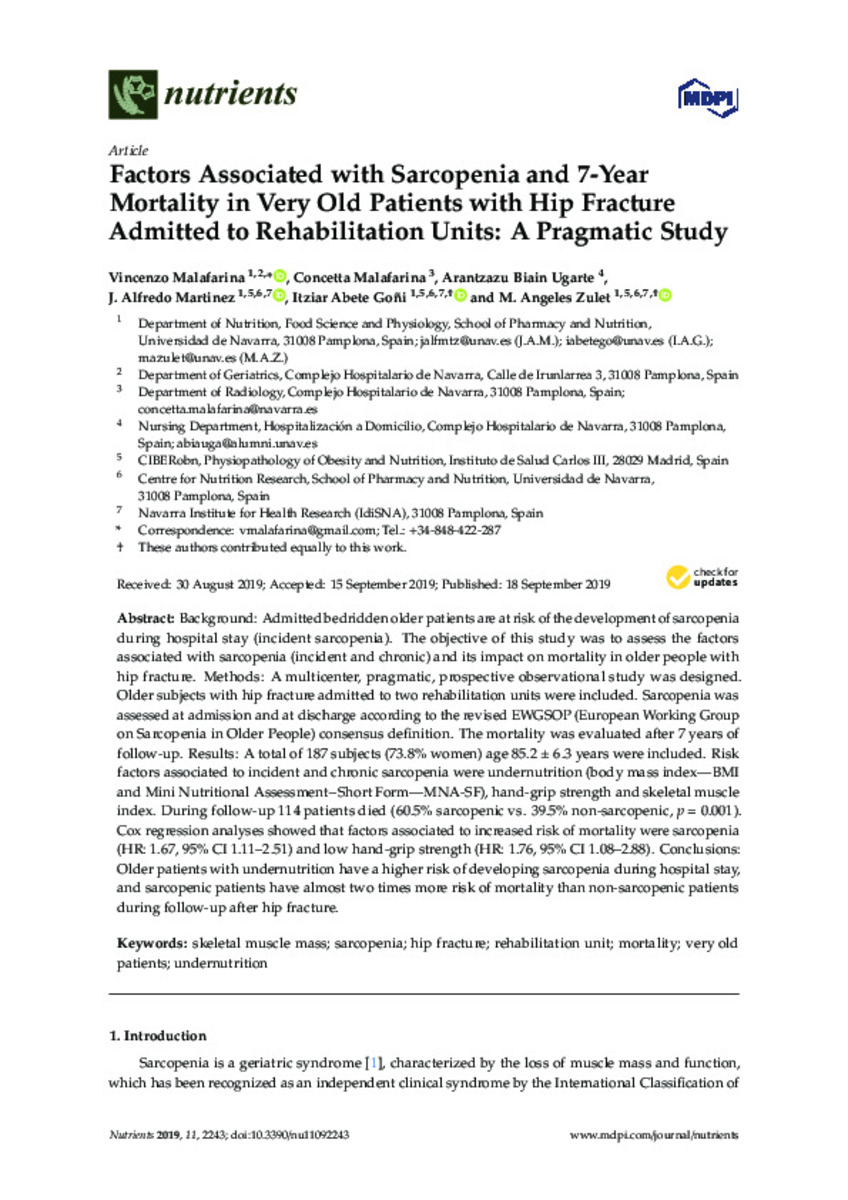Full metadata record
| DC Field | Value | Language |
|---|---|---|
| dc.creator | Malafarina, V. (Vincenzo) | - |
| dc.creator | Malafarina, C. (Concetta) | - |
| dc.creator | Biain-Ugarte, A. (Arantzazu) | - |
| dc.creator | Martinez, A. (Alfredo) | - |
| dc.creator | Abete, I. (Itziar) | - |
| dc.creator | Zulet, M.A. (María Ángeles) | - |
| dc.date.accessioned | 2021-09-23T09:45:56Z | - |
| dc.date.available | 2021-09-23T09:45:56Z | - |
| dc.date.issued | 2019 | - |
| dc.identifier.citation | Malafarina, V. (Vincenzo); Malafarina, C. (Concetta); Biain-Ugarte, A. (Arantzazu); et al. "Factors Associated with Sarcopenia and 7-Year Mortality in Very Old Patients with Hip Fracture Admitted to Rehabilitation Units: A Pragmatic Study". Nutrients. 11 (2243), 2019, 1 - 15 | es |
| dc.identifier.issn | 2072-6643 | - |
| dc.identifier.other | PMID: 31540409 | - |
| dc.identifier.uri | https://hdl.handle.net/10171/62057 | - |
| dc.description.abstract | Background: Admitted bedridden older patients are at risk of the development of sarcopenia during hospital stay (incident sarcopenia). The objective of this study was to assess the factors associated with sarcopenia (incident and chronic) and its impact on mortality in older people with hip fracture. Methods: A multicenter, pragmatic, prospective observational study was designed. Older subjects with hip fracture admitted to two rehabilitation units were included. Sarcopenia was assessed at admission and at discharge according to the revised EWGSOP (European Working Group on Sarcopenia in Older People) consensus definition. The mortality was evaluated after 7 years of follow-up. Results: A total of 187 subjects (73.8% women) age 85.2 ± 6.3 years were included. Risk factors associated to incident and chronic sarcopenia were undernutrition (body mass index-BMI and Mini Nutritional Assessment-Short Form-MNA-SF), hand-grip strength and skeletal muscle index. During follow-up 114 patients died (60.5% sarcopenic vs. 39.5% non-sarcopenic, p = 0.001). Cox regression analyses showed that factors associated to increased risk of mortality were sarcopenia (HR: 1.67, 95% CI 1.11-2.51) and low hand-grip strength (HR: 1.76, 95% CI 1.08-2.88). Conclusions: Older patients with undernutrition have a higher risk of developing sarcopenia during hospital stay, and sarcopenic patients have almost two times more risk of mortality than non-sarcopenic patients during follow-up after hip fracture. | es_ES |
| dc.language.iso | eng | es_ES |
| dc.publisher | MDPI AG | es_ES |
| dc.rights | info:eu-repo/semantics/openAccess | es_ES |
| dc.subject | Materias Investigacion::Ciencias de la Salud::Nutrición y dietética | es_ES |
| dc.subject | Hip fracture | es_ES |
| dc.subject | Mortality | es_ES |
| dc.subject | Rehabilitation unit | es_ES |
| dc.subject | Sarcopenia | es_ES |
| dc.subject | Skeletal muscle mass | es_ES |
| dc.subject | Undernutrition | es_ES |
| dc.subject | Very old patients | es_ES |
| dc.title | Factors Associated with Sarcopenia and 7-Year Mortality in Very Old Patients with Hip Fracture Admitted to Rehabilitation Units: A Pragmatic Study | es_ES |
| dc.type | info:eu-repo/semantics/article | es_ES |
| dc.description.note | This article is an open access article distributed under the terms and conditions of the Creative Commons Attribution (CC BY) license (http://creativecommons.org/licenses/by/4.0/). | es_ES |
| dc.identifier.doi | 10.3390/nu11092243 | - |
| dadun.citation.endingPage | 15 | es_ES |
| dadun.citation.number | 2243 | es_ES |
| dadun.citation.publicationName | Nutrients | es_ES |
| dadun.citation.startingPage | 1 | es_ES |
| dadun.citation.volume | 11 | es_ES |
Files in This Item:
Statistics and impact
Items in Dadun are protected by copyright, with all rights reserved, unless otherwise indicated.






